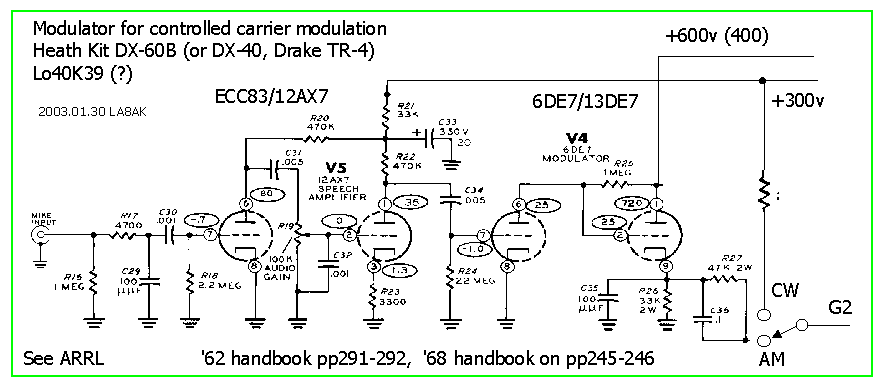
Reference page: F.96) Styre- eller
fanggittermodulasjon
Controlled carrier - an alternative for the surplus transmitter?
Read
what Bruce AB7YD says:

this circuit is a part of Heath DX-60
Comments from Bruce AB7YD:
According to some of the ARRL handbooks, controlled-carrier is
preferred
over basic screen modulation because it allows more overall power
output
than basic screen modulation. I can't say that their description
of why
this was so made much sense to me, so I won't reproduce it here.
I've used the Heath controlled-carrier modulator on my DX-40,
DX-60,
Seneca, and Cheyenne. It went through several changes and
upgrades to
get to the final DX-60B version. It does make for a simple and
effective modulator when properly set up. However it does have
some
drawbacks. For example, the low resting-carrier output can make
for
tiring listening conditions for the person on the receiving end,
because
between words your carrier drops way down letting the background
noise
come up. If the receiver can be set for long AGC time constant,
this
effect can be somewhat reduced, but most die-hard AM folks don't
even
think of using "SSB AGC" on an AM signal.
Another point of interest is that the 807 and 1625 tubes are not
well
suited to screen modulation because of a kink in the screen
current
characteristic as it nears zero volts, causing distortion. The
6146 is
very much better in this respect and is to be preferred.
----
You are correct in the operation of the first triode of the 6DE7.
The
tube is essentially biased into full saturation by the 22 meg
grid
resistor and the 1 meg plate resistor. Its action is somewhat
akin to a
grid-leak detector. The audio voltage appearing at its plate
turns out
to be a sinewave clamped atop a small positive pedestal. The
second
triode of the 6DE7 is just acting as a cathode follower. The
voltage
appearing at its cathode is just the same sine wave clamped to a
higher
positive pedestal.
The paralleled RC at the output cathode establishes the extent of
modulation in the negative direction. I've had to slightly adjust
the
value of that resistor (R27 in the diagram) to get perfect 100%
modulation (i.e. the positive and negative peaks flat-top
simultaneously).
Heath went through several variants of this screen modulator. In
the
DX-40 and Seneca, the entire modulator was run off the 300 vdc
low B+
supply. In the Cheyenne and DX-60 series, the 6DE7 was run off
the +600
vdc supply.
There was also considerable variation in the input and output RC
time
constants over those models. The time constant determines the
"hang-time" of the carrier, i.e. the period of time
that the carrier is
held at the elevated level between words. It was fairly short on
the
DX-40, Cheyenne, and Seneca, but lengthened considerably on the
DX-60.
I was always intrigued by this circuit, because on first glance
it
appears to be a totally linear amplifier. Of course in
large-signal
behavior, it certainly isn't. It really is a clever circuit, and
is
quite stable when all parts are good and of the correct value.
The only
distortion I've seen in going through the circuit is a slight bit
of
positive peak flattening at the grid of the first 6DE7 triode,
caused by
the high driving impedance of the 12Ax7 microphone preamp..
----
Thanks for the response and the additional info on the original
query.
I feel that the controlled-carrier screen modulator is perhaps
the most
cost effective way to get decent AM on a transmitter. It does
come with
liabilities, however, and should not be expected to compete with
more
costly high-level plate modulated approaches.
The most obvious limitation of the screen, cathode, and control
grid
modulators is that they are all limited to the CW pep rating of
the
transmitter in question, whereas the high-level schemes ideally
allow up
to 4 times the CW pep output on the instantaneous audio peaks,
because
they are driving the final plate voltage up to twice its resting
level.
It is an interesting exercise to try and design a transmitter
that would
be optimized for controlled-carrier screen grid modulation. To a
first
approximation, you find that you need a high voltage, but low
current
power supply, and an RF final tube that has a higher than
expected
dissipation rating. It would be an unusual beast indeed.
You might also be interested, theoretically at least, in a rather
strange approach I saw used in a home-built mobile transmitter of
the
1950's vintage. It had a typical plate modulated configuration,
however
there was no B+ supplied to the RF finals!! Instead, the output
of the
modulator stage was fed to a diode and capacitor clamp, which
clamped
the negative audio peak to ground. This output was then supplied
as B+
to the RF final. The result was a high-level plate modulated
signal
with unusual characteristics. For one thing, it produced a 100%
modulated carrier at all audio levels. It also produced no
carrier
output whatsoever when you weren't speaking. I don't think it
would
make for very pleasant listening, hi!
